Understanding the Effect of Introducing Micro- and Nanoparticle Bismuth Oxide (Bi2O3) on the Gamma Ray Shielding Performance of Novel Concrete
Abstract
:1. Introduction
2. Materials and Methods
2.1. Samples Preparation
2.2. Samples Characterization
2.3. Geant4 Code
2.4. Attenuation Measurement
2.5. Shielding Parameters:
3. Results and Discussion
4. Conclusions
- The LAC results demonstrated that increasing the amount of nanoparticle Bi2O3 improves the shielding ability of the concrete since the LAC values have the trend of C-N5 < C-N10 < C-N15.
- At all energies, the C-0 has the greatest HVL, while C-N15 has the least. Thus, C-N15 concrete is the most space efficient, while C-0 is the least space efficient.
- The MFP is evaluated for C-0, C-B5, and C-N5 concretes and the MFP values at 0.662 MeV are equal to 4.78, 5.07, and 5.25 cm for C-0, C-B5, and C-N5, respectively, which demonstrated that the C-N5 sample has the best shielding ability out of these three concretes.
- The radiation protection efficiency (RPE) of the prepared concretes was found to decrease with increasing energy for all five samples.
- The RPE results revealed that increasing the energy of the photons leads to decreased capability for these concretes to shield the incoming radiation. Finally, C-N5 has a greater RPE than C-B5; this result demonstrates that Bi2O3 NP are more efficient at shielding radiation than bulk Bi2O3.
Author Contributions
Funding
Institutional Review Board Statement
Informed Consent Statement
Data Availability Statement
Conflicts of Interest
References
- Dong, M.; Zhou, S.; Xue, X.; Feng, X.; Sayyed, M.I.; Khandaker, M.U.; Bradley, D.A. The potential use of boron containing resources for protection against nuclear radiation. Radiat. Phys. Chem. 2021, 188, 109601. [Google Scholar] [CrossRef]
- Sayyed, M.I.; Al-Hadeethi, Y.; AlShammari, M.M.; Ahmed, M.; Al-Heniti, S.H.; Rammah, Y.S. Physical, optical and gamma radiation shielding competence of newly borotellurite based glasses: TeO2–B2O3–ZnO–Li2O3–Bi2O3. Ceram. Int. 2021, 47, 611–618. [Google Scholar] [CrossRef]
- Malkapur, S.M.; Ghodke, S.S.; Sujatha, P.; Singh, Y.; Shivakumar, K.; Sen, M.; Narasimhan, M.C.; Pulgur, A.V. Waste-polymer incorporated concrete mixes for neutron and gamma radiation shielding. Prog. Nucl. Energy 2021, 135, 103694. [Google Scholar] [CrossRef]
- Aygün, B.; Şakar, E.S.; Agar, O.; Sayyed, M.I.; Karabulut, A.; Singh, V.P. Development of new heavy concretes containing chrome-ore for nuclear radiation shielding applications. Prog. Nucl. Energy 2021, 133, 103645. [Google Scholar] [CrossRef]
- Khan, M.U.; Ahmad, S.; Naqvi, A.A.; Al-Gahtani, H.J. Shielding performance of heavy-weight ultra-high-performance concrete against nuclear radiation. Prog. Nucl. Energy 2020, 130, 103550. [Google Scholar] [CrossRef]
- Skarzynski, Ł. Mechanical and radiation shielding properties of concrete reinforced with boron-basalt fibers using Digital Image Correlation and X-ray micro-computed tomography. Constr. Build. Mater. 2020, 255, 119252. [Google Scholar] [CrossRef]
- Lee, C.-M.; Lee, Y.H.; Lee, K.J. Cracking effect on gamma-ray shielding performance in concrete structure. Prog. Nucl. Energy 2007, 49, 303–312. [Google Scholar] [CrossRef]
- Azeez, A.B.; Mohammed, K.S.; Sandu, A.V.; Al Bakri AM, M.; Kamarudin, H.; Sandu, I.G. Evaluation of radiation shielding properties for concrete with different aggregate granule sizes. Rev. Chim.-Buchar. 2013, 64, 899–903. [Google Scholar]
- Madej, D.; Silarski, M.; Parzych, S. Design, structure, microstructure and gamma radiation shielding properties of refractory concrete materials containing Ba- and Sr-doped cements. Mater. Chem. Phys. 2021, 260, 124095. [Google Scholar] [CrossRef]
- Prochon, P.; Piotrowski, T. The effect of cement and aggregate type and w/c ratio on the bound water content and neutron shielding efficiency of concretes. Constr. Build. Mater. 2020, 264, 120210. [Google Scholar] [CrossRef]
- Lotfi-Omran, O.; Sadrmomtazi, A.; Nikbin, I.M. The influences of maximum aggregate size and cement content on the mechanical and radiation shielding characteristics of heavyweight concrete. Prog. Nucl. Energy 2020, 121, 103222. [Google Scholar] [CrossRef]
- Lotfi-Omran, O.; Sadrmomtazi, A.; Nikbin, I.M. A comprehensive study on the effect of water to cement ratio on the mechanical and radiation shielding properties of heavyweight concrete. Construct. Build. Mater. 2019, 229, 116905. [Google Scholar] [CrossRef]
- Demir, I.; Gümüs, M.; Gokçe, H.S. Gamma ray and neutron shielding characteristics of polypropylene fiber-reinforced heavyweight concrete exposed to high temperatures. Construct. Build. Mater. 2020, 257, 119596. [Google Scholar] [CrossRef]
- Sikora, P.; El-Khayatt, A.M.; Saudi, H.; Chung, S.-Y.; Stephan, D.; Elrahman, M.A. Evaluation of the effects of bismuth oxide (Bi2O3) micro and nanoparticles on the mechanical, microstructural and γ-ray/neutron shielding properties of Portland cement pastes. Constr. Build. Mater. 2021, 284, 122758. [Google Scholar] [CrossRef]
- Khalaf, M.A.; Cheah, C.B.; Ramli, M.; Ahmed, N.M.; Al-Shwaiter, A. Effect of nano zinc oxide and silica on mechanical, fluid transport and radiation attenuation properties of steel furnace slag heavyweight concrete. Constr. Build. Mater. 2021, 274, 121785. [Google Scholar] [CrossRef]
- Norhasri, M.M.; Hamidah, M.; Fadzil, A.M. Applications of using nano material in concrete: A review. Constr. Build. Mater. 2017, 133, 91–97. [Google Scholar] [CrossRef]
- Mesbahi, A.; Ghiasi, H. Shielding properties of the ordinary concrete loaded with micro- and nano-particles against neutron and gamma radiations. Appl. Radiat. Isot. 2018, 136, 27–31. [Google Scholar] [CrossRef]
- Xu, S.; Xie, N.; Cheng, X.; Huang, S.; Feng, L.; Hou, P.; Zhu, Y. Environmental resistance of cement concrete modified with low dosage nano particles. Constr. Build. Mater. 2018, 164, 535–553. [Google Scholar] [CrossRef]
- Janković, K.; Stanković, S.; Bojović, D.; Stojanović, M.; Antić, L. The influence of nano-silica and barite aggregate on properties of ultra high performance concrete. Constr. Build. Mater. 2016, 126, 147–156. [Google Scholar] [CrossRef]
- Zhou, D.; Zhang, Q.-P.; Zheng, J.; Wu, Y.; Zhao, Y.; Zhou, Y.-L. Co-shielding of neutron and γ-ray with bismuth borate nanoparticles fabricated via a facile sol-gel method. Inorg. Chem. Commun. 2017, 77, 55–58. [Google Scholar] [CrossRef]
- Basu, P.C.; Labbe, P.; Nuas, D.J. Nuclear Power Plant Concrete Structures. In Proceedings of the 22nd Conference on Structural Mechanics in Reactor Technology, San Francisco, CA, USA, 18–23 August 2013. [Google Scholar]
- Piotrowskia, T.; Tefelskib, D.B.; Sokołowskaa, J.J.; Jaworska, B. New Generation Shielding against Ionizing Radiation Concrete. Acta Phys. Pol. A 2015, 128, 9–13. [Google Scholar] [CrossRef]
- Briesmeister, J.F. MCNP^<TM>-A General Monte Carlo N-Particle Transport Code, Version 4C, LA-13709-M. 2000. Available online: https://inspirehep.net/files/78c669e8d3bb59ccf6fb868a6061450c (accessed on 19 October 2021).
- Badawi, M.; Noureddine, S.; Kopatch, Y.; Abbas, M.; Ruskov, I.; Grozdanov, D.; Thabet, A.; Fedorov, N.; Gouda, M.; Hramco, C.; et al. Characterization of the efficiency of a cubic NaI detector with rectangular cavity for axially positioned sources. J. Instrum. 2020, 15, P02013. [Google Scholar] [CrossRef]
- Hurtado, S.; Garcıa-León, M.; Garcıa-Tenorio, R. GEANT4 code for simulation of a germanium gamma-ray detector and its application to efficiency calibration. Nucl. Instrum. Methods Phys. Res. Sect. A Accel. Spectrometers Detect. Assoc. Equip. 2004, 518, 764–774. [Google Scholar] [CrossRef]
- Abbas, M.I.; Badawi, M.S.; Thabet, A.A.; Kopatch, Y.N.; Ruskov, I.N.; Grozdanov, D.N.; Noureddine, S.; Fedorov, N.A.; Gouda, M.M.; Hramco, C.; et al. Efficiency of a cubic NaI (Tl) detector with rectangular cavity using standard radioactive point sources placed at non-axial position. Appl. Radiat. Isot. 2020, 163, 109139. [Google Scholar] [CrossRef]
- Brun, R.; Rademakers, F. ROOT—An object oriented data analysis framework. Nucl. Instrum. Methods Phys. Res. Sect. A Accel. Spectrometers Detect. Assoc. Equip. 1997, 389, 81–86. [Google Scholar] [CrossRef]
- Elsafi, M.; Alzahrani, J.S.; Abbas, M.I.; Gouda, M.M.; Thabet, A.A.; Badawi, M.S.; El-Khatib, A.M. Geant4 Tracks of NaI Cubic Detector Peak Efficiency, Including Coincidence Summing Correction for Rectangular Sources. Nucl. Sci. Eng. 2021, 195, 1008–1016. [Google Scholar] [CrossRef]
- Elsafi, M.; El-Nahal, M.A.; Sayyed, M.I.; Saleh, I.H.; Abbas, M.I. Effect of bulk and nanoparticle Bi2O3 on attenuation capability of radiation shielding glass. Ceram. Int. 2021, 47, 19651–19658. [Google Scholar] [CrossRef]
- Creagh, D.C.; Hubbell, J.H. Problems associated with measurement of x-ray attenuation coefficients. Acta Cryst. 1987, A43, 102–112. [Google Scholar] [CrossRef]
- Abbas, M.I. Validation of analytical formulae for the efficiency calibration of gamma detectors used in laboratory and in-situ measurements. Appl. Radiat. Isot. 2006, 64, 1661–1664. [Google Scholar] [CrossRef]
- Abbas, M.I. A new analytical method to calibrate cylindrical phoswich and LaBr3(Ce) scintillation detectors. Nucl. Instruments Methods Phys. Res. Sect. A Accel. Spectrometers Detect. Assoc. Equip. 2010, 621, 413–418. [Google Scholar] [CrossRef]
- Kavaz, E.; Ekinci, N.; Tekin, H.O.; Sayyed, M.I.; Aygün, B.; Perişanoğlu, U. Estimation of gamma radiation shielding qualification of newly developed glasses by using WinXCOM and MCNPX code. Prog. Nucl. Energy 2019, 115, 12–20. [Google Scholar] [CrossRef]
- Rammah, Y.; Ali, A.; El-Mallawany, R.; El-Agawany, F. Fabrication, physical, optical characteristics and gamma-ray competence of novel bismo-borate glasses doped with Yb2O3 rare earth. Phys. B Condens. Matter 2020, 583, 412055. [Google Scholar] [CrossRef]
- Almuqrin, A.H.; Sayyed, M.I. Radiation shielding characterizations and investigation of TeO2–WO3–Bi2O3 and TeO2–WO3–PbO glasses. Appl. Phys. A 2021, 127, 190. [Google Scholar] [CrossRef]
- Sayyed, M.I.; Elmahroug, Y.; Elbashir, B.O.; Issa, S. Gamma-ray shielding properties of zinc oxide soda lime silica glasses. J. Mater. Sci. Mater. Electron. 2016, 28, 4064–4074. [Google Scholar] [CrossRef]
- Rammah, Y.S.; Abouhaswa, A.S.; Sayyed, M.I.; Tekin, H.O.; El-Mallawany, R. Structural, UV and shielding properties of ZBPC glasses. J. Non-Cryst. Solids 2019, 509, 99–105. [Google Scholar] [CrossRef]
- Tekin, H.O.; Syyed, M.I.; Altunsoy, E.E.; Manici, T. Shielding properties and effects of wo3 and pbo on mass attenuation coefficients by using MCNPX code. Dig. J. Nanomater. Biostructures 2017, 12, 861–867. [Google Scholar]
- Sayyed, M.I.; Akyildirim, H.; Al-Buriahi, M.S.; Lacomme, E.; Ayad, R.; Bonvicini, G. Oxyfluoro-tellurite-zinc glasses and the nuclear-shielding ability under the substitution of AlF3 by ZnO. Appl. Phys. A 2020, 126, 88. [Google Scholar] [CrossRef]

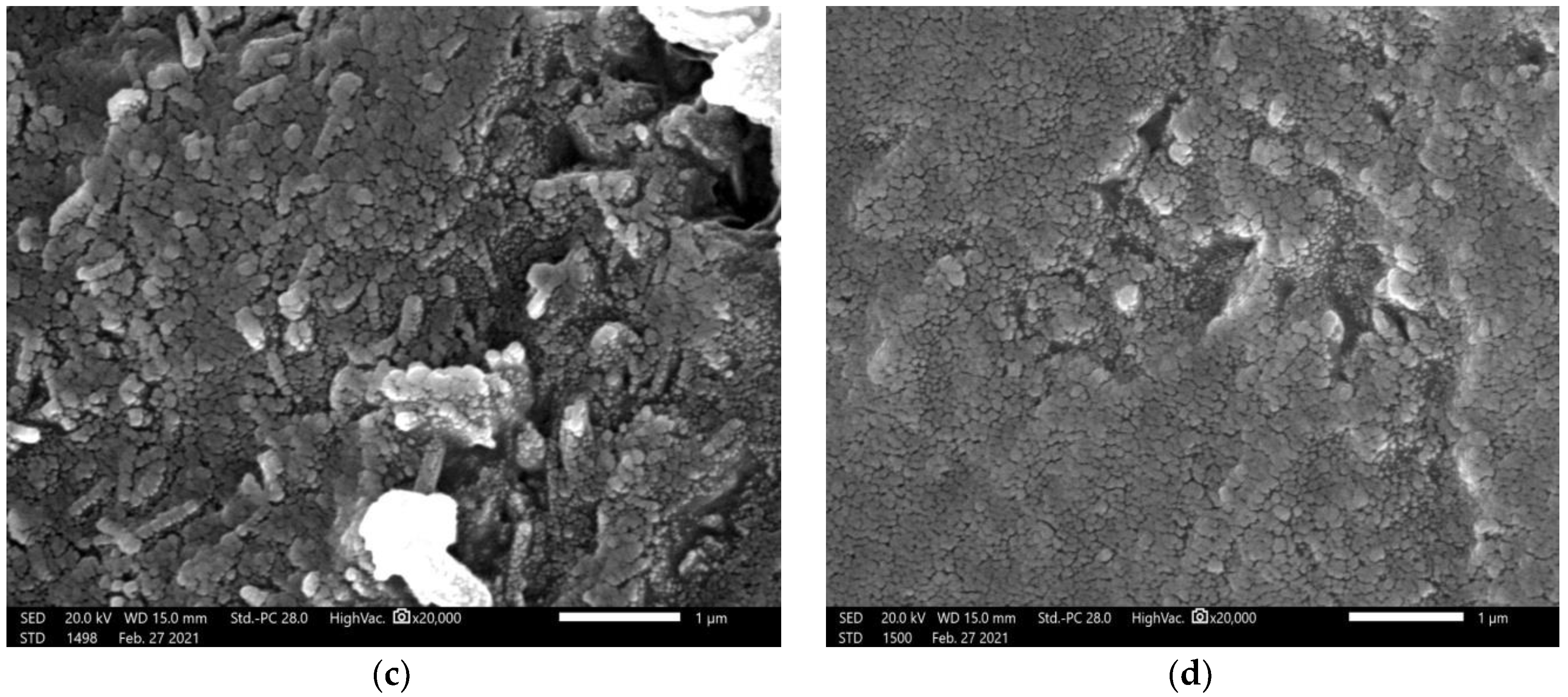

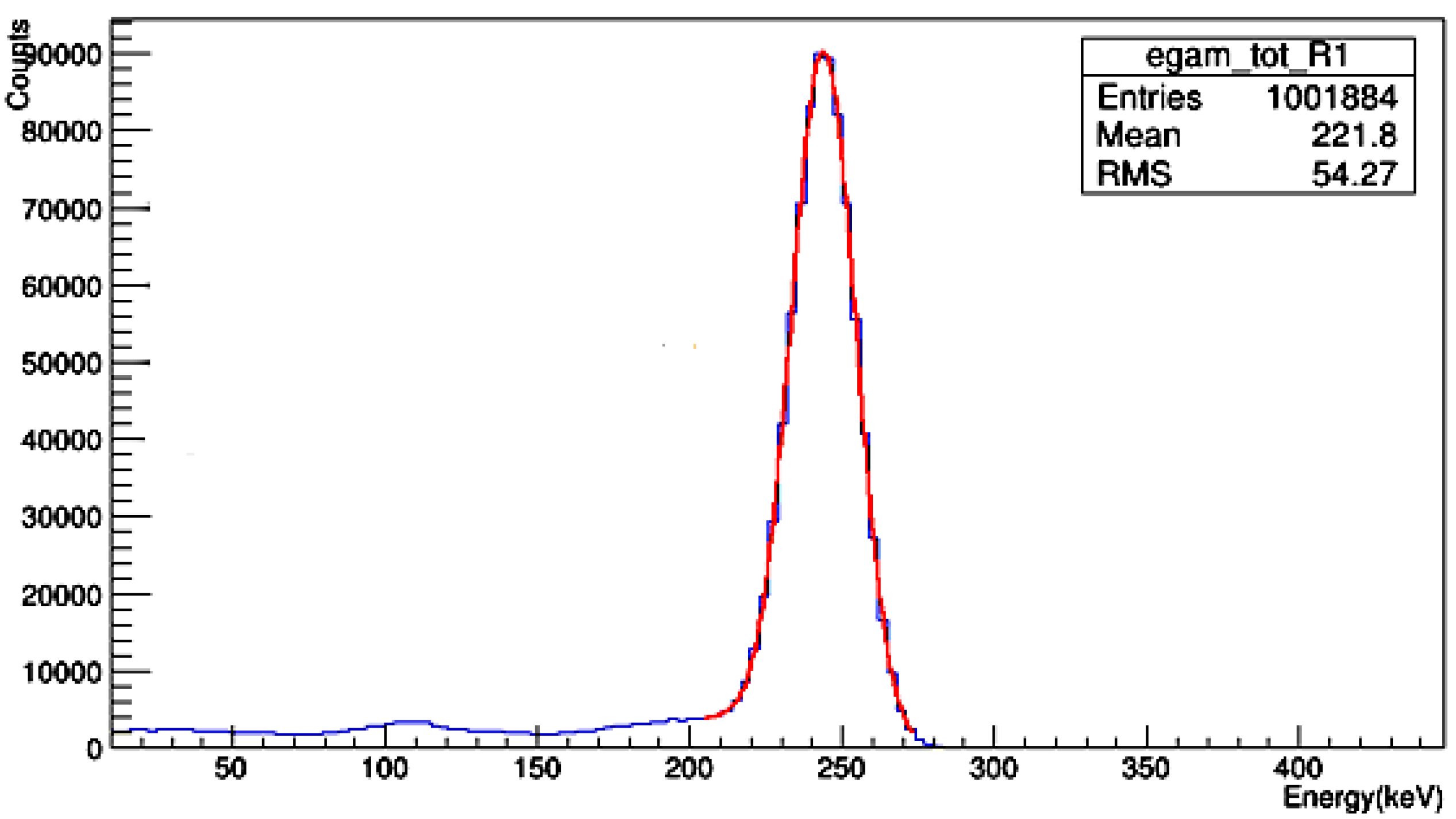
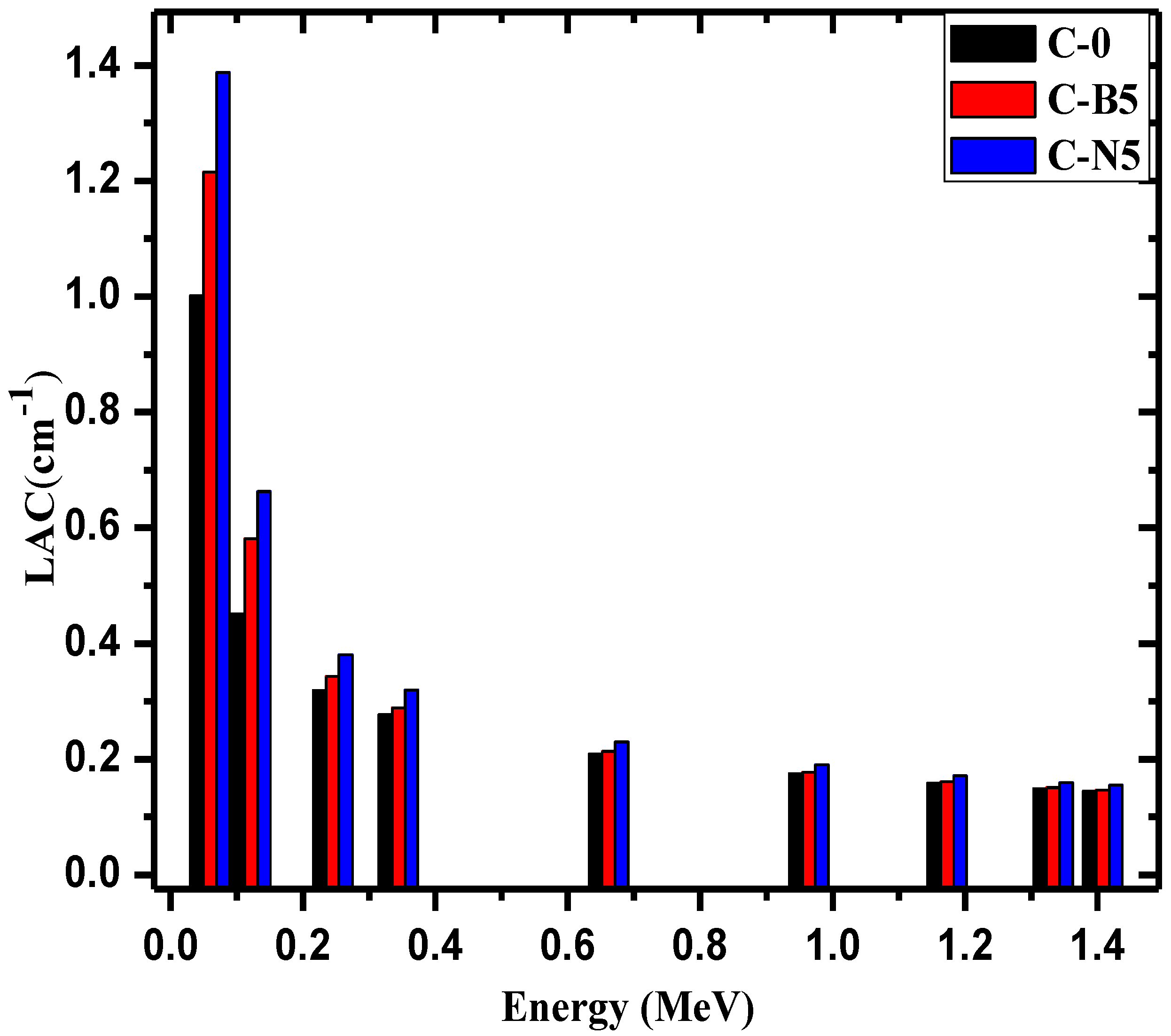
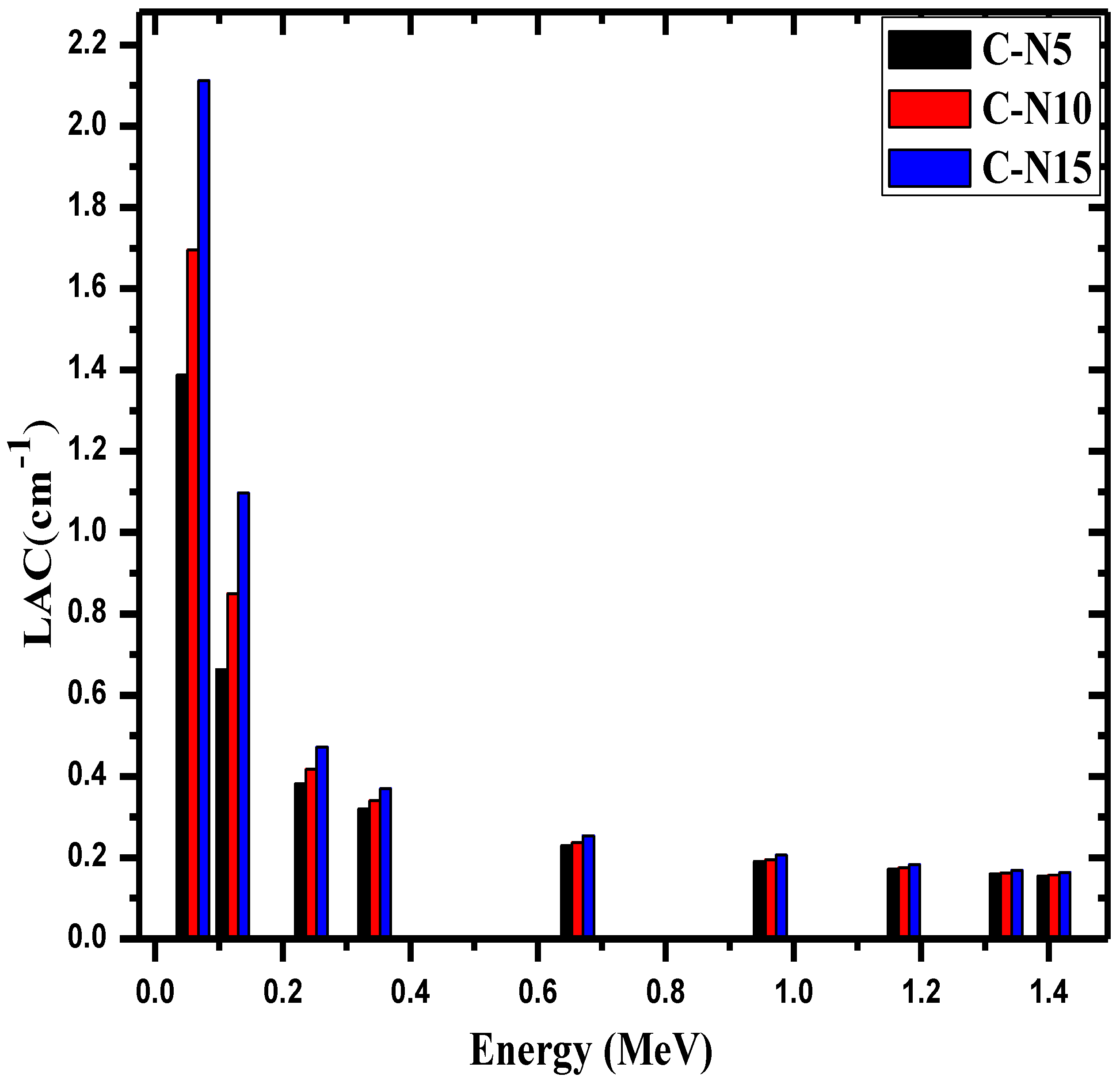
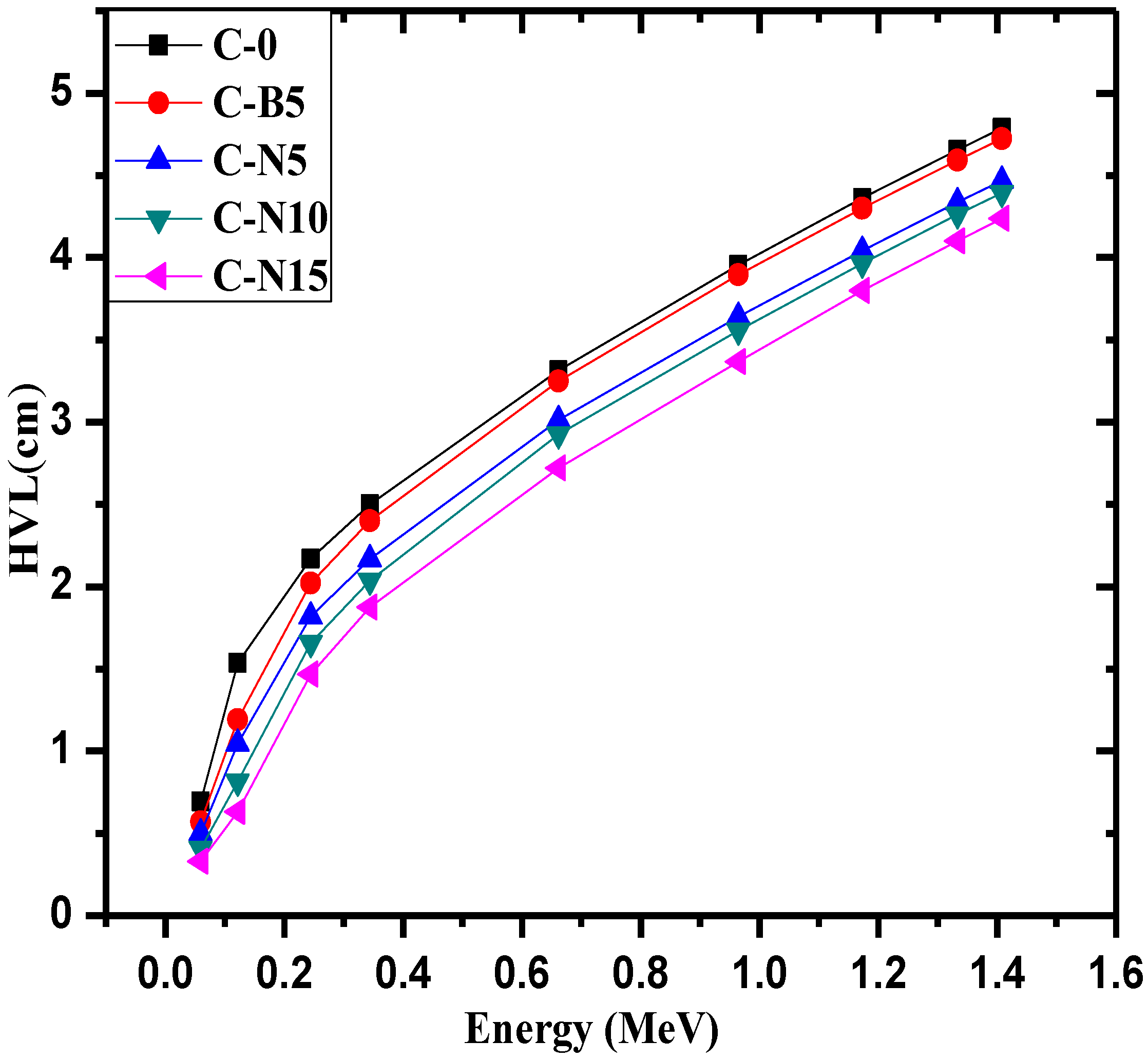

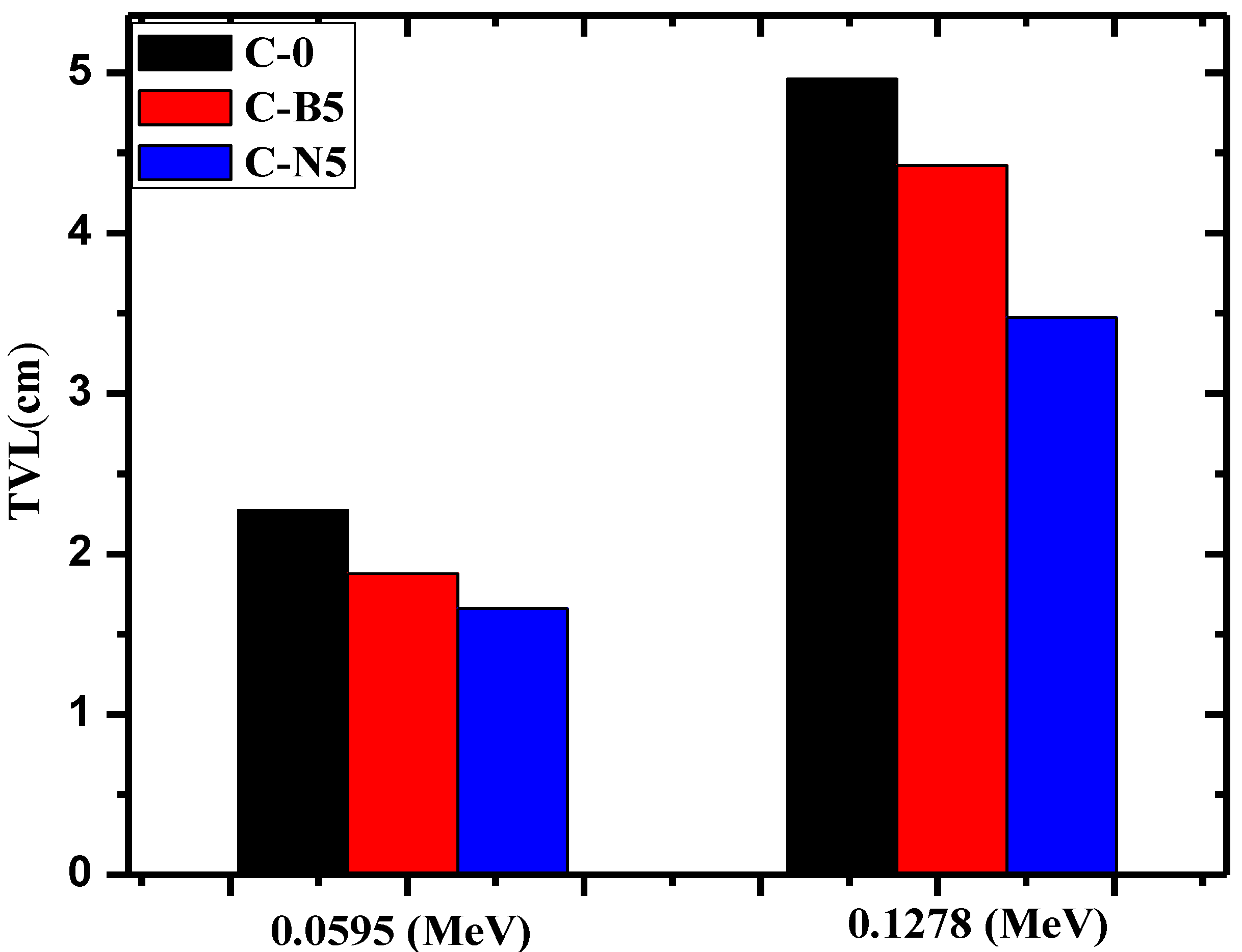
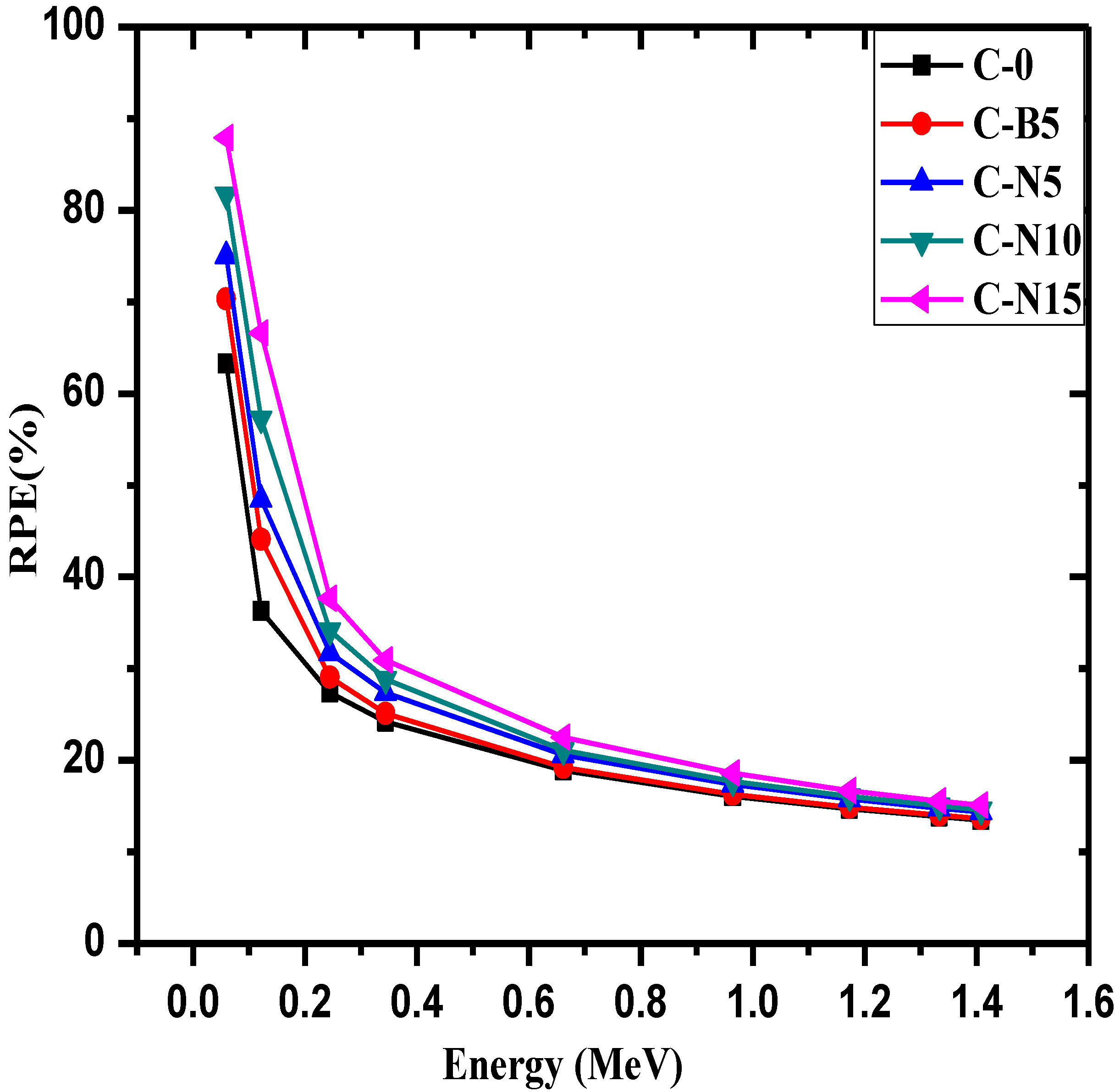
| Concrete Sample Code | Water Dosage, kg/m3 | Cement Dosage, kg/m3 | Fine Aggregate, kg/m3 (0–4 mm) | Coarse Aggregate (Galala Marble) kg/m3 (<10 mm) | W/C | |||
|---|---|---|---|---|---|---|---|---|
| Sand | Bulk-Bi2O3 | Nano-Bi2O3 | Bi2O3 wt% | |||||
| C-0 Blank | 208 | 417 | 625 | 0 | 0 | 0 | 1250 | 0.50 |
| C-B5 | 208 | 417 | 594 | 31 | 0 | 5 | ||
| C-B7 | 208 | 417 | 581 | 44 | 0 | 7 | ||
| C-N5 | 208 | 417 | 594 | 0 | 31 | 5 | ||
| C-N10 | 208 | 417 | 563 | 0 | 63 | 10 | ||
| C-N15 | 208 | 417 | 531 | 0 | 94 | 15 | ||
| Elements | C-0 | C-B5 | C-B7 | C-N5 | C-N10 | C-N15 |
|---|---|---|---|---|---|---|
| C | 25.44 | 23.07 | 22.12 | 24.49 | 21.5 | 20.2 |
| O | 46.95 | 45.5 | 46.32 | 47.85 | 46.05 | 47.05 |
| Na | 0.57 | 0.33 | 0.23 | 0.35 | 0.2 | 0.28 |
| Mg | 0.77 | 0.7 | 0.64 | 0.77 | 0.74 | 0.81 |
| Al | 1.96 | 1.75 | 1.83 | 2.51 | 2.36 | 2.14 |
| Si | 8.73 | 10.55 | 11.51 | 8.73 | 9.3 | 8.3 |
| S | 0.86 | 0.82 | 0.79 | 0.8 | 0.81 | 0.9 |
| Ca | 11.47 | 12.6 | 11.44 | 10.02 | 12.9 | 11.87 |
| Fe | 3.05 | 3.14 | 2.97 | 2.91 | 3.1 | 3.9 |
| Bi | 0 | 1.34 | 1.95 | 1.37 | 2.84 | 4.35 |
| Total | 100 | 100 | 100 | 100 | 100 | 100 |
| Density, g/cm3 | 2.70 | 2.74 | 2.80 | 2.73 | 2.75 | 2.78 |
| Nuclide | Energy, MeV | Emission Probability | Activity, kBq | Uncertainty |
|---|---|---|---|---|
| Am-241 | 0.0595 | 35.9 | 259 | ±2.6 |
| Cs-137 | 0.662 | 34.1 | 385 | ±4.0 |
| Eu-152 | 0.122 | 28.4 | 290 | ±4.0 |
| 0.245 | 26.6 | |||
| 0.344 | 14 | |||
| 0.964 | 20.87 | |||
| 1.408 | 85.21 | |||
| Co-60 | 1.173 | 99.9 | 212.1 | ±1.5 |
| 1.333 | 99.982 |
| Sample | Energy, MeV | MAC, cm2/g | ∆1% | ∆2% | ||
|---|---|---|---|---|---|---|
| XCOM | EXP | Geant4 | ||||
| C-0 | 0.0595 | 0.3708 | 0.3754 | 0.3736 | 1.23 | 0.46 |
| 0.662 | 0.1670 | 0.1696 | 0.1710 | 1.55 | −0.85 | |
| 0.122 | 0.1182 | 0.1194 | 0.1182 | 1.01 | 1.01 | |
| 0.245 | 0.1026 | 0.1016 | 0.1018 | −0.98 | −0.22 | |
| 0.344 | 0.0774 | 0.0765 | 0.0760 | −1.2 | 0.65 | |
| 0.964 | 0.0649 | 0.0657 | 0.0654 | 1.22 | 0.45 | |
| 1.408 | 0.0588 | 0.0585 | 0.0586 | −0.55 | −0.25 | |
| 1.173 | 0.0551 | 0.0555 | 0.0550 | 0.78 | 0.99 | |
| 1.333 | 0.0536 | 0.0541 | 0.0538 | 0.88 | 0.42 | |
| C-B5 | 0.0595 | 0.4440 | 0.4484 | 0.4508 | −0.97 | −0.55 |
| 0.662 | 0.2126 | 0.2100 | 0.2113 | 1.24 | −0.63 | |
| 0.122 | 0.1254 | 0.1246 | 0.1235 | 0.63 | 0.87 | |
| 0.245 | 0.1055 | 0.1068 | 0.1058 | −1.25 | 0.99 | |
| 0.344 | 0.0779 | 0.0795 | 0.0799 | −1.97 | −0.58 | |
| 0.964 | 0.0650 | 0.0660 | 0.0665 | −1.53 | −0.77 | |
| 1.408 | 0.0589 | 0.0588 | 0.0582 | 0.19 | 1.02 | |
| 1.173 | 0.0552 | 0.0545 | 0.0542 | 1.15 | 0.54 | |
| 1.333 | 0.0536 | 0.0539 | 0.0539 | −0.58 | 0.12 | |
| C-B7 | 0.0595 | 0.4698 | 0.4772 | 0.4762 | 1.58 | 0.22 |
| 0.662 | 0.2325 | 0.2305 | 0.2285 | −0.87 | 0.85 | |
| 0.122 | 0.1285 | 0.1301 | 0.1295 | 1.22 | 0.44 | |
| 0.245 | 0.1068 | 0.1049 | 0.1038 | −1.82 | 1.02 | |
| 0.344 | 0.0781 | 0.0793 | 0.0797 | 1.44 | −0.58 | |
| 0.964 | 0.0651 | 0.0656 | 0.0649 | 0.77 | 1.01 | |
| 1.408 | 0.0589 | 0.0591 | 0.0598 | 0.28 | −1.15 | |
| 1.173 | 0.0552 | 0.0557 | 0.0559 | 1.024 | −0.25 | |
| 1.333 | 0.0536 | 0.0544 | 0.0541 | 1.44 | 0.55 | |
Publisher’s Note: MDPI stays neutral with regard to jurisdictional claims in published maps and institutional affiliations. |
© 2021 by the authors. Licensee MDPI, Basel, Switzerland. This article is an open access article distributed under the terms and conditions of the Creative Commons Attribution (CC BY) license (https://creativecommons.org/licenses/by/4.0/).
Share and Cite
El-Nahal, M.A.; Elsafi, M.; Sayyed, M.I.; Khandaker, M.U.; Osman, H.; Elesawy, B.H.; Saleh, I.H.; Abbas, M.I. Understanding the Effect of Introducing Micro- and Nanoparticle Bismuth Oxide (Bi2O3) on the Gamma Ray Shielding Performance of Novel Concrete. Materials 2021, 14, 6487. https://doi.org/10.3390/ma14216487
El-Nahal MA, Elsafi M, Sayyed MI, Khandaker MU, Osman H, Elesawy BH, Saleh IH, Abbas MI. Understanding the Effect of Introducing Micro- and Nanoparticle Bismuth Oxide (Bi2O3) on the Gamma Ray Shielding Performance of Novel Concrete. Materials. 2021; 14(21):6487. https://doi.org/10.3390/ma14216487
Chicago/Turabian StyleEl-Nahal, Mohamed A., Mohamed Elsafi, M. I. Sayyed, Mayeen Uddin Khandaker, Hamid Osman, Basem H. Elesawy, Ibrahim H. Saleh, and Mahmoud I. Abbas. 2021. "Understanding the Effect of Introducing Micro- and Nanoparticle Bismuth Oxide (Bi2O3) on the Gamma Ray Shielding Performance of Novel Concrete" Materials 14, no. 21: 6487. https://doi.org/10.3390/ma14216487
APA StyleEl-Nahal, M. A., Elsafi, M., Sayyed, M. I., Khandaker, M. U., Osman, H., Elesawy, B. H., Saleh, I. H., & Abbas, M. I. (2021). Understanding the Effect of Introducing Micro- and Nanoparticle Bismuth Oxide (Bi2O3) on the Gamma Ray Shielding Performance of Novel Concrete. Materials, 14(21), 6487. https://doi.org/10.3390/ma14216487













